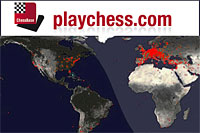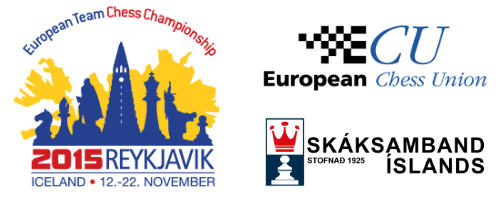
European Team Chess Championshio R01: Top seeds have it easy

Watch it live on Playchess!
The 20th European Team Chess Championships 2015 (ETCC2015) for the open and women section are being held from 13th to 22nd of November 2015 in Reykjavik, Iceland. 36 European countries are playing in the open section while 30 are in action in the women’s. A few weeks ago we reported on the European Club Cup 2015. The European Team Championship differs from the Club Cup in the fact that the players represent their own countries – much more national pride is at stake in this event. The winning team in both sections gets a direct entry into the next World Team Championships. The top seed in the open section is Russia with an average Elo of 2743, while in the women section we have Georgia with a rating of 2517 at the top.
It is a nine round Swiss event with one round being played every day. 18th November is the rest day, when the players will be taken on an excursion to Golden Circle and Fischer’s Grave. The rate of play is 90 min for 40 moves + 30 min for the rest of the game + 30 sec increment for every move played starting from the first move.
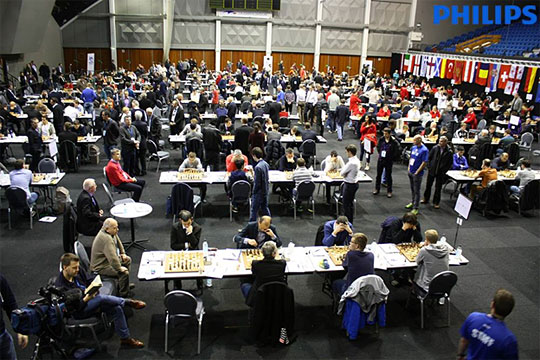
The tournament is being played in the same venue as the famous Fischer-Spassky match of 1972 ...

... and David Howell and Jovanka Houska feel what it’s like to sit on the same chairs as Fischer and Spassky

Three important men: Omar Salama, chief arbiter, Gunnar Bjornsson, chief organizer,
and Zurab Azmaiparashvili, President of the European Chess Union
Open Section
The first round in the open section pitted grandmasters against each other. The top six seeds – Russia, Ukraine, France, Azerbaijan, England and Armenia, were able to beat their opponents quite easily. A typical score was 3:1, with two players winning and two drawing. Armenia managed to completely blank their opponents Iceland 4:0.
For the top seeds Russia, who had won the gold medal back in 2007, it was their national champion Evgeny Tomashevsky who struck the first blood against Turkey’s Alexander Ipatov. And what a game it was!

[Event "20th European Teams"] [Site "Reykjavik ISL"] [Date "2015.11.13"] [Round "1.2"] [White "Tomashevsky, Evgeny"] [Black "Ipatov, Alexander"] [Result "1-0"] [ECO "D52"] [WhiteElo "2743"] [BlackElo "2624"] [Annotator "Sagar Shah"] [PlyCount "67"] [EventDate "2015.11.13"] [WhiteTeam "Russia"] [BlackTeam "Turkey"] [WhiteTeamCountry "RUS"] [BlackTeamCountry "TUR"] 1. c4 c6 2. Nf3 d5 3. d4 Nf6 4. Nc3 e6 5. Bg5 Nbd7 6. e3 Qa5 {The famous Cambridge Springs Variation.} 7. cxd5 (7. Nd2 {is the main line.}) 7... Nxd5 8. Rc1 Nxc3 9. bxc3 Ba3 (9... Qxa2 10. Bd3 Qa5 11. O-O $44 {gives White excellent lead in development.}) 10. Rc2 b6 11. Be2 Ba6 12. O-O Bxe2 {All this has been played in nine games before and top players like Carlsen, Ding and Tomashevsky himself had captured on e2 with the queen. But here Evgeny had a novelty up his sleeve!} 13. Rxe2 $5 $146 O-O (13... Qxc3 14. Rc2 Qa5 15. Rxc6 $16) 14. e4 {Tomashevsky would like to keep his rook on e3 to defend the c3 pawn and swing over to the kingside whenever required.} Rfe8 (14... Qxc3 15. Rc2 Qa5 16. Rxc6 Rac8 {could be something that can be explored by black players.}) 15. Re3 { Played after 25 minutes of thought. This is very common for Tomashevsky, who takes a lot of time for complicated decisions in the opening.} Bf8 16. e5 $5 Qxa2 {This is a very interesting situation. Black has won a pawn on a2 but White has good attacking chances. His idea is to play Nd2-e4 followed by queen coming out to g4 or h5 and the rook swinging over to g3 or h3. Computers assess such positions in Black's favour, but practically during a game it is very difficult to defend. In fact in this particular position I would say that White has an extremely strong attack.} 17. Nd2 {[%cal Gd2e4,Ge3h3,Ge3g3,Gd1g4, Gg4h5]} c5 18. Ne4 cxd4 19. cxd4 Rac8 20. Qg4 $6 ({Much more accurate was} 20. Rh3 {threatening Qh5.} g6 21. Qf3 $1 Qd5 22. Qf4 $18 {[%csl Ge4,Gf4,Gg5,Gh3] With these four pieces in the attack Black can just pray that some divine power will save him. But in reality he is dead lost.}) 20... Rc4 21. Rf3 Rxd4 22. Qf4 Ra8 $2 (22... Nxe5 23. Qxe5 Qc4 {would have given Black realistic chances of defence.}) 23. Qxf7+ Kh8 {[#]} 24. Bf6 $3 {The move that Ipatov most probably missed –and it is the only move that wins! The threat is Rg3.} Rxe4 (24... gxf6 25. Rg3 $18) 25. Rg3 Nxf6 26. exf6 g6 27. Rh3 h6 28. Qxg6 Qd2 29. Qxe4 (29. Rg3 $1) 29... Rc8 30. Rd3 Qc2 31. Qxe6 Qc6 32. Qg4 Rc7 33. Qg6 Qe6 34. Rd8 {A very nice attacking game by Tomashevsky. His idea of taking on e2 with the rook and then following it up with Re3 and then e5, Nd2-e4, Qg4 and finally crowning his attack with the pretty Bf6! led to a very consistent game.} 1-0

Evgeny Tomashevsky (above) won his game and so did
Dmitry Jakovenko to give Russians a 3-1 victory over Turkey
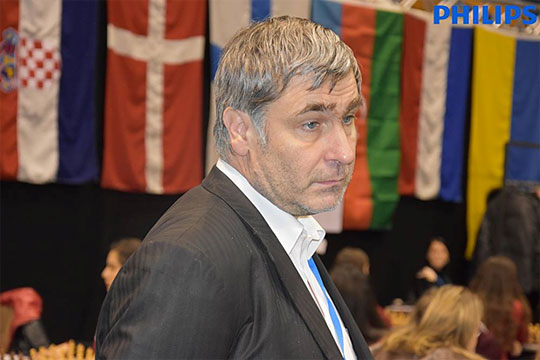
Vassily Ivanchuk was in a creative mood today and made sure that his team beat the Romanians (3:1)

[Event "20th European Teams"] [Site "Reykjavik ISL"] [Date "2015.11.13"] [Round "1.1"] [White "Ivanchuk, Vassily"] [Black "Lupulescu, Constantin"] [Result "1-0"] [ECO "D37"] [WhiteElo "2720"] [BlackElo "2631"] [Annotator "Sagar Shah"] [PlyCount "89"] [EventDate "2015.11.13"] [WhiteTeam "Ukraine"] [BlackTeam "Romania"] [WhiteTeamCountry "UKR"] [BlackTeamCountry "ROU"] 1. d4 Nf6 2. c4 e6 3. Nf3 d5 4. Nc3 Be7 5. Qc2 O-O 6. cxd5 exd5 7. Bg5 h6 8. Bh4 Na6 9. e3 Nb4 10. Qb3 Bf5 11. Rc1 c5 {Lupulescu's last move is a clear indication that he wants to make use of his lead in development. It looks scary for White as he is still is some time away from castling. But Ivanchuk knows no fears.} 12. dxc5 $1 Qa5 13. Nd4 $1 Nd3+ (13... Bg6 14. Be2 Nd3+ 15. Bxd3 Bxd3 16. c6 {transposes to the game.}) 14. Bxd3 Bxd3 {At first sight this looks pretty good for Black who has prevented his opponent from castling. But the Ukrainian has seen further.} 15. c6 $1 (15. Qxb7 {is also strong, but humans don't play this way when their king is in the centre.}) 15... Bc4 16. Qa4 Qc5 (16... Qxa4 17. Nxa4 bxc6 18. Nxc6 Bd6 {is the best line of play according to the computer. But for a human player it looks pretty bad to go into such an ending with a pawn less.} 19. Bxf6 gxf6 20. b3 Bb5 21. Nd4 $16) 17. cxb7 Rab8 18. b3 Bd3 19. Kd2 $1 {I like this bold move connecting the rooks. The king feels at home on d2.} Bg6 20. Bxf6 $1 {A nice simplifying idea. } Bxf6 21. Ne4 Qe7 22. Nc5 (22. Nc6 $1 {would have been very strong. I wonder why Ivanchuk rejected it.} Qxb7 23. Nxf6+ gxf6 24. Nxb8 Rxb8 25. Qd4 $18) 22... Be5 23. g3 Bd6 24. Nd7 Bb4+ 25. Ke2 Bh5+ 26. Kf1 Bd2 27. Rc2 (27. Rc7 {was strong. Ivanchuk's move looks winning on the surface, but it gives Black strong counterplay.}) 27... Rxb7 28. Nxf8 Rb4 $6 (28... Qe4 $1 {would have muddied the water to quite some extent.} 29. Kg1 (29. Rg1 Qd3+ 30. Kg2 Qe4+ 31. f3 Bxf3+ 32. Nxf3 Qxc2 $13) 29... Rb4 {The threat is to take the knight on d4.} 30. Rxd2 $1 Rxa4 31. bxa4 Qb1+ 32. Kg2 Qe4+ 33. f3 Qxe3 34. Rhd1 Kxf8 35. g4 $16 {White is better, but winning this will not be a piece of cake.}) 29. Rc8 $1 Qe4 (29... Rxa4 30. Ng6+ $18) 30. Nfe6+ Kh7 31. Nf8+ Kg8 {Repeating the position to gain time on the clock.} 32. Ng6+ $1 {Ivanchuk finds the only way to win.} Kh7 33. Rh8+ Kxg6 34. Qc6+ f6 (34... Kg5 35. h4+ Kg4 36. Qd7+ f5 37. Qxg7+ $18) 35. Qe8+ $1 {The queens are exchanged and White's material advantage is brought home.} Qxe8 36. Rxe8 Bc3 37. Nc2 Re4 38. Rxe4 dxe4 39. Nd4 Bf3 40. Nxf3 exf3 {This would have been a nice position had there been pawns on h3 and g4 for Black. But here the rook gets into the game quite easily.} 41. g4 h5 42. gxh5+ Kxh5 43. Rg1 g5 44. Rg3 g4 45. h3 (45. h3 f5 46. hxg4+ fxg4 47. Rg1 $18 {[%cal Gg1h1,Gh1h7]}) 1-0
The Ukrainian team looks extremely well balanced this year. The World Cup 2015 hero Pavel Eljanov rested in the first round, but we will soon see him in action and it will be exciting to follow him. Just in case you were wondering how top players like Eljanov prepare for an event like this, here’s a tweet by the Ukrainian number one which will give you an idea:
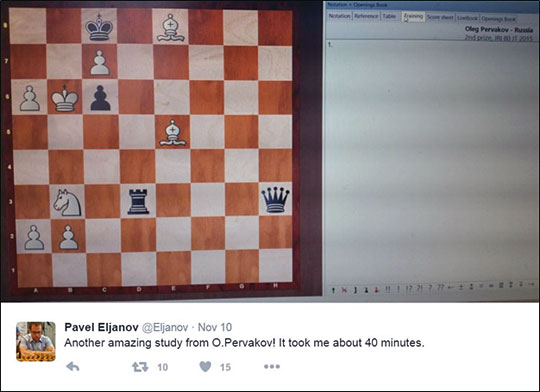
It’s White to play and win. Try solving the position and see if you can beat Eljanov’s time.
Two upsets of the day were Moldova’s draw against Hungary and Austria holding Poland. In both the matches it was the top board that failed for the higher rated teams – Bologan got the better of Peter Leko while Markus Ragger beat Radoslaw Wojtaszek.

[Event "20th European Teams"] [Site "Reykjavik ISL"] [Date "2015.11.13"] [Round "1.25"] [White "Bologan, Viktor"] [Black "Leko, Peter"] [Result "1-0"] [ECO "C67"] [WhiteElo "2630"] [BlackElo "2708"] [Annotator "Sagar Shah"] [PlyCount "148"] [EventDate "2015.11.13"] {This game is an impressive display of understanding of the opening by Bologan and also about the conversion of a technical advantage. And it's always nice to see a decisive game in the Berlin.} 1. e4 e5 2. Nf3 Nc6 3. Bb5 Nf6 4. O-O Nxe4 5. d4 Nd6 6. Bxc6 dxc6 7. dxe5 Nf5 8. Qxd8+ Kxd8 9. Rd1+ Ke8 10. Nc3 Ne7 11. h3 Ng6 12. b3 Be7 13. Bb2 h5 14. Ne4 {This is well known and Bologan himself had a game against Aronian which went 14...h4 in 2012. But here the Hungarian comes up with a new move.} a5 $5 {This doesn't really change the character of the play but forces Viktor to think over the board and come up with some moves.} 15. Re1 $1 Kf8 (15... a4 {Peter most probably refrained from this move because of} 16. Nd6+ $1 cxd6 (16... Kf8 17. Nxc8 Rxc8 18. bxa4 $16 { It's an ugly pawn on a4 but a pawn is a pawn!}) 17. exd6 $16) 16. Rad1 h4 17. Nd6 $1 {Just two moves out of his opening preparation and Leko has a very difficult position. This was excellent played by Bologan.} Rh5 (17... Nxe5 18. Bxe5 Bxd6 (18... cxd6 19. Bxg7+ $1) 19. Rxd6 cxd6 20. Bxd6+ Kg8 21. Re8+ Kh7 22. Ng5+ Kg6 23. Rxh8 $16) 18. Nxc8 Rxc8 19. Re4 $1 {The main reason why White is better here is because of his superior co-ordination.} Rd8 20. Rxd8+ Bxd8 21. Kf1 $1 {Good players always make use of their kings.} c5 22. Rg4 Ke7 23. Ng5 f5 $6 (23... Nf8 $14) 24. exf6+ gxf6 25. Re4+ $1 Kd7 26. Ne6 Be7 27. Ng7 Rh7 28. Nf5 $16 {By some nice knight moves White has left his opponent with some weaknesses and no activity.} Bd8 29. Ke2 Rh5 30. Rg4 Rxf5 31. Rxg6 {This position is extremely difficult to defend for Black as he has too many weaknesses.} Ke6 32. Rh6 Rg5 33. Kf1 Rd5 34. Rxh4 {One down.} Rd2 35. Re4+ $1 Kf7 36. Re2 {Keeping control.} Rd1+ 37. Re1 Rd2 38. Rc1 {This is just temporary passivity.} c4 39. bxc4 {Two down.} Be7 40. Bc3 Rd6 41. Re1 $18 { White is two pawns up and he is not intending to return any one of them. The rest of the game is interesting if you would like to improve your chess technique, but from the objective stand point White is already winning.} Rc6 42. Re4 a4 43. Ke2 a3 44. g4 Rb6 45. Rd4 Bd6 46. Rd5 Rb1 47. Rf5 Be7 48. g5 Kg6 49. gxf6 Bd6 50. Rf3 Kf7 51. Rd3 Rc1 52. c5 Bf8 53. Rd2 Ke6 54. Bd4 Bh6 55. Be3 Bxe3 56. fxe3 Kxf6 57. Kd3 Rh1 58. Kc4 Ke6 59. Rd3 Rxh3 60. Rxa3 Kd7 61. Kb5 Rh5 62. Rd3+ Kc8 63. a4 b6 64. Rc3 Re5 65. a5 bxc5 66. Kc6 c4 67. Ra3 c3 68. a6 Kb8 69. a7+ Ka8 70. Rxc3 Re7 71. Ra3 Re6+ 72. Kd5 Rd6+ 73. Ke4 Rd2 74. c4 c6 1-0
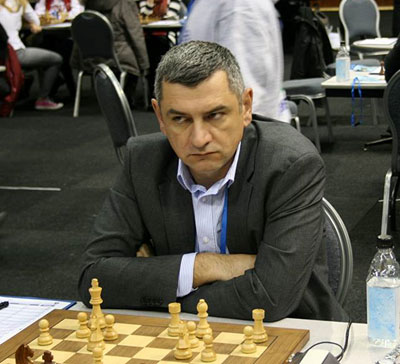
Viktor Bologan’s mean look is not good news for his opponent
Just in case you were wondering how Bologan managed to outplay such an elite opponent like Leko in a complex opening like the Berlin Wall, here’s the reason – Viktor recently recorded four hours and seven minutes of chess material for ChessBase on the Berlin Wall. This just shows that when you study an opening deeply with one colour, you start playing it well with the other colour as well! Eljanov made a DVD on the Ruy Lopez Breyer and played excellently at the World Cup 2015. It won’t come as surprise to us if Viktor simply crushes the field here!
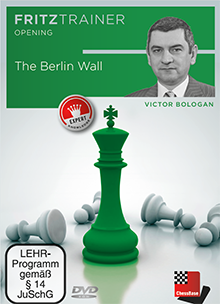 Viktor Bologan: The Berlin Wall Viktor Bologan: The Berlin Wall
Languages: English
ISBN: 978-3-86681-496-7
Delivery: Download, Post
Level: Tournament player, Professional
Price: €29.90 or €25.13 without VAT (for Customers outside the EU) $27.06 (without VAT)
"The Berlin Wall, also known as the Berlin Defense, is one of the most solid and frequently played openings of the 21st century, and compared to the real Berlin Wall, there’s almost no chance of it falling. Introduced into serious practice during the WCC match between Kasparov and Kramnik in London in 2000, it heralded a change in chess from the dynamic and romantic style of the 20th century towards a more pragmatic, solid, resourceful and forwardlooking approach. Kramnik won the match and the Berlin Defense became extremely popular.
The DVD is divided into two parts. In the first section, we look at what happens when White avoids the endgame in the “Anti-Berlin” systems, while the second section deals with the Berlin ending. Lately, White has been playing Anti-Berlin setups much more frequently - as they cannot find anything in the main Berlin. In a way, this alone is testament to its power! The endgame should be treated as serious, complex setting with lots of possibilities, including many tactical tricks.
It goes without saying that studying the Berlin Defense will improve your understanding of the endgame dramatically. The course also includes a number of exercises aimed at improving your practical skills in the Berlin. The DVD caters for a wide range of audiences that ranges from beginners right through to highly skilled players. Add the Berlin Wall into your repertoire and pass the headache of “what to play against it?” to your opponent!
- Video running time: 4 hours 07 min(English)
- With interactive training including video feedback
- Exclusive database with over 50 essential games plus analysis by Bologan
- Including CB 12 Reader
Viktor Bologan is a pupil of the top Moldavan trainer Vecheslav Chebanenko. For many years Bologan has been the number one in Moldava and has represented his country in eight Chess Olympiads. His greatest successes were in 2003, when he first of all won the Aeroflot Open and then the famous Dortmund Tournament, ahead of Kramnik and Anand. The Moldovan has extensive experience as a trainer and has also published his first books.
Order Viktor Bologan's Berlin Wall DVD in the ChessBase Shop
|
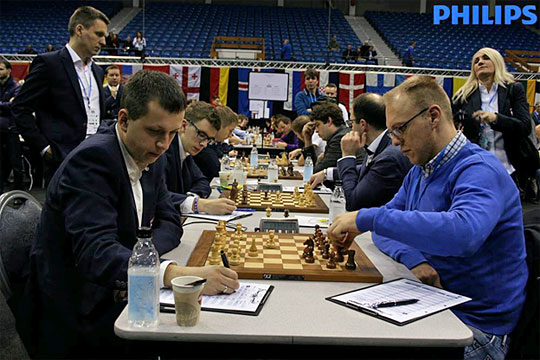
Ragger was able to beat Wojtaszek from the Black side of the c6-d5 variation in Grunfeld. This ensured that Austria holds Poland to a 2:2 draw.

[Event "20th European Teams"] [Site "Reykjavik ISL"] [Date "2015.11.13"] [Round "1.29"] [White "Wojtaszek, Radoslaw"] [Black "Ragger, Markus"] [Result "0-1"] [ECO "E60"] [WhiteElo "2748"] [BlackElo "2688"] [Annotator "Sagar Shah"] [PlyCount "88"] [EventDate "2015.11.13"] 1. d4 Nf6 2. c4 g6 3. Nf3 Bg7 4. g3 c6 5. Bg2 d5 6. Qb3 O-O 7. O-O Qb6 8. Nc3 Rd8 9. Na4 Qxb3 10. axb3 Na6 11. Bf4 Ne8 12. Nc3 Nac7 13. Ra4 a6 14. Rd1 Be6 15. h3 Rac8 16. c5 h6 17. g4 g5 18. Bh2 f5 19. gxf5 Bxf5 20. Ne5 Nf6 21. Raa1 Rf8 22. e3 Ne6 23. f3 Rcd8 24. b4 Nd7 25. Nxd7 Rxd7 26. Rd2 Bg6 27. Ne2 Nd8 28. Rf1 Nf7 29. f4 e6 30. Kh1 Kh7 {Nothing special is going on in the position and it is round about equal. But here Wojtaszek makes an uncharacteristic positional error.} 31. Ng1 $2 {It seems as if nothing is happening but Ragger is alert and takes his opportunity.} gxf4 $1 32. exf4 (32. Bxf4 e5 $1 33. dxe5 Re7 $17 {gives Black a clearcut positional advantage.}) 32... Nh8 $1 {An excellent move by Markus. He would like to place his bishop on f5 and then his knight on g6 and attack the f4 pawn.} 33. Re1 ({Just have a look how White can end up in a completely lost position if he plays the natural moves.} 33. Nf3 Be4 34. Ne5 Bxg2+ 35. Kxg2 Bxe5 36. dxe5 Ng6 $17 {[%cal Gd7g7,Gg6e7,Ge7f5] The bishop on h2 is a dead pieces, while the knight will rule like a king on f5.}) 33... Bf5 34. Nf3 Ng6 35. Ne5 Bxe5 $1 {Of course the g6 knight is more important than the bishop.} 36. fxe5 Nh4 37. Bg3 Nxg2 38. Kxg2 Rg7 $1 {What started as a positional idea has translated into an attack on the white king.} 39. Kh2 Be4 40. Rg1 Rf3 41. h4 Bf5 42. Rgg2 Rg4 43. Bf2 Rh3+ $1 44. Kg1 (44. Kxh3 Rxd4+ $19) 44... Be4 $1 {A very pretty finish.} 0-1
The Germans were able to beat Switzerland with a score of 2.5-1.5, Daniel Fridman needed a lot of luck to win against Sebastian Bogner and the other three games ended in a draw, but they were not peaceful ones. Just have a look at this crazy game between the talented 18-year-old Dennis Wagner and the chess historian Richard Forster.

[Event "20th European Teams"] [Site "Reykjavik ISL"] [Date "2015.11.13"] [Round "1.4"] [White "Forster, Richard"] [Black "Wagner, Dennis"] [Result "1/2-1/2"] [ECO "A01"] [WhiteElo "2459"] [BlackElo "2575"] [Annotator "Sagar Shah"] [PlyCount "91"] [EventDate "2015.11.13"] [WhiteTeam "Switzerland"] [BlackTeam "Germany"] [WhiteTeamCountry "SUI"] [BlackTeamCountry "GER"] 1. b3 {When facing a young and ambitious opponent who studies openings in great depth, it seems like a good choice by Forster to go for 1.b3.} e5 2. Bb2 Nc6 3. e3 Nf6 4. Bb5 Bd6 5. Ne2 a6 6. Bxc6 dxc6 7. d3 Qe7 8. e4 Be6 9. O-O O-O-O $5 {Combative play by Wagner. It would have been normal to just 0-0.} 10. Nd2 h5 11. b4 h4 12. a4 Nh5 (12... h3 $1 {was the faster way to reach the gates of White's castle.} 13. g3 Bxb4 14. Bxe5 Bg4 {With superior co-ordination, although the game is still by no means over.}) 13. b5 $1 {Good or bad, lines have to be opened!} cxb5 14. axb5 axb5 15. Ra5 c6 {Black has won a pawn and is objectively better. But in a practical game White has good chances as there are open lines leading to the black king.} 16. Qa1 f6 17. d4 Bb4 18. Ba3 $1 Kc7 19. d5 {Richard mixes up things in the position. Apart from the wierd pin on the b4 bishop, now the d5 pawn has moved ahead to sacrifice itself in order to open lines.} Bg4 20. Nc3 Bxa3 (20... Nf4 $5 {is clearly better for Black but difficult to understand why. Black now threatens moves like Qc5 with a threat of taking on c3 and then a fork on e2 could be a real possibility. In general the kinght is really well placed on f4.}) 21. Rxa3 (21. Qxa3 Qxa3 22. Rxa3 b4 $19) 21... Bd7 $2 (21... b4 $2 {Now this doesn't work due to} 22. Ra7 $1 bxc3 23. Rxb7+ $1 Kxb7 24. Rb1+ Kc7 25. Qa7+ Kd6 26. Nc4#) ( 21... Nf4 {was required as after} 22. Ra7 Qc5 23. Qa5+ Qb6 24. Qa2 Qc5 {the game ends in a draw.}) 22. Ra7 $1 Rb8 (22... Qc5 23. Qa5+ Qb6 {no longer works due to} 24. d6+ $1 {and now you see why retreating the bishop to d7 was bad!}) 23. Qa5+ Kc8 24. dxc6 (24. Na4 $1 {was the finishing stroke.} bxa4 25. Nc4 $1 Bg4 26. d6 Qf7 27. Nb6+ Kd8 28. Ra8 $18) 24... Bxc6 25. Nxb5 Qd8 $1 {Good defence.} 26. Qc3 Nf4 27. Re1 Kd7 28. Qb3 Qb6 (28... Ke7 {was better but its not so easy to keep your cool in such wild positions.}) 29. Qf7+ $1 Kd8 30. Qxg7 Re8 31. Qxf6+ Kd7 {It's almost a miracle that Black survived this. He is unconditionally lost.} 32. Nc4 $1 Qxb5 33. Rd1+ $1 Kc7 34. Qf7+ $1 Bd7 35. Nd6 (35. Ra5 {was faster as after} Qc6 36. Rc5 $18 {the queen is lost or the king is mated.}) 35... Nh3+ 36. Kh1 Qe2 37. Nxe8+ Kb6 38. Qb3+ (38. Rd6+ Kxa7 39. Qa2+ $18) 38... Bb5 39. Raa1 $2 (39. Rxb7+ Rxb7 40. Qe6+ Bc6 (40... Ka7 41. Ra1+ Ba6 42. Qxh3 $18 {was still winning.}) 41. Rb1+ Ka7 42. Ra1+ Kb6 43. Qb3+ Bb5 44. gxh3 $18) 39... Nxf2+ 40. Kg1 Nxd1 {Now White will do well to take a perpetual check.} 41. Qe6+ Bc6 42. Rb1+ Ka7 43. Ra1+ Kb6 44. Rb1+ Ka7 45. Ra1+ Kb6 46. Rb1+ {A very interesting game. This analysis by no means shows all the possibilities for both sides. There were just too many. It just gives you an idea of how crazy a game of chess can be!} 1/2-1/2

One of Germany’s brightest talents: GM Dennis Wagner
Some of the other upsets were Montenegro beating Norway 2.5-1.5 (Carlsen took a rest on the first day). Everyone is eagerly looking forward to him getting into action from round two. Denmark was able to beat the Czech Republic 2.5-1.5 when David Navara lost on the top board to Sune Berg Hansen. The unheralded team from Finland was able to get the better of the strong Latvian team consisting of Shirov and Kovalenko. Kosovo are playing for the first time in the European Team Championships and they lost to Greece.
Round one results
| No. |
Sd |
Team |
MP
|
Pts.
|
: |
Pts.
|
MP
|
Team |
Sd |
| 1 |
19 |
Turkey |
0
|
1
|
: |
3
|
0
|
Russia |
1 |
| 2 |
2 |
Ukraine |
0
|
3
|
: |
1
|
0
|
Romania |
20 |
| 3 |
21 |
Slovenia |
0
|
1
|
: |
3
|
0
|
Azerbaijan |
3 |
| 4 |
4 |
France |
0
|
3
|
: |
1
|
0
|
Sweden |
22 |
| 5 |
23 |
Italy |
0
|
1
|
: |
3
|
0
|
England |
5 |
| 6 |
6 |
Armenia |
0
|
4
|
: |
0
|
0
|
Iceland |
24 |
| 7 |
25 |
Moldova |
0
|
2
|
: |
2
|
0
|
Hungary |
7 |
| 8 |
8 |
Poland |
0
|
2
|
: |
2
|
0
|
Austria |
26 |
| 9 |
27 |
Iceland Legends |
0
|
½
|
: |
3½
|
0
|
Netherlands |
9 |
| 10 |
10 |
Germany |
0
|
2½
|
: |
1½
|
0
|
Switzerland |
28 |
| 11 |
29 |
Montenegro |
0
|
2½
|
: |
1½
|
0
|
Norway |
11 |
| 12 |
12 |
Czech Republic |
0
|
1½
|
: |
2½
|
0
|
Denmark |
30 |
| 13 |
31 |
Finland |
0
|
2½
|
: |
1½
|
0
|
Latvia |
13 |
| 14 |
14 |
Spain |
0
|
3½
|
: |
½
|
0
|
Belgium |
32 |
| 15 |
33 |
Lithuania |
0
|
2
|
: |
2
|
0
|
Serbia |
15 |
| 16 |
16 |
Croatia |
0
|
3
|
: |
1
|
0
|
Faroe Islands |
34 |
| 17 |
35 |
Scotland |
0
|
0
|
: |
4
|
0
|
Georgia |
17 |
| 18 |
18 |
Greece |
0
|
2½
|
: |
1½
|
0
|
Kosovo |
36 |
Full individual results
Women Section
The Georgian ladies are on a high. A few weeks ago they represented the team Nona at the European Club Cup and waltzed to the first place on the final standings. In Reykjavik they have a much stronger bottom order and are surely the favourites to win the title. The team consists of Nana Dzagnidze, Bela Khotenashvili, Lela Javakhishvili, Nino Batsiashvili and Meri Arabidze. They beat Czech Republic in the first round with a score of 3.5:0.5.

Nana Dzagnidze (above) has been in scintillating form lately. After a dismal start at the Monaco FIDE Grand Prix 2015 she won the last four games. Later she played brilliantly at the European Club Cup 2015, scoring 5.5/7. She is truly the backbone of the Georgian team.
The two other teams which could give the Georgian ladies a run for their money are the Russians and Ukrainians. The Russian team of Alexandra Kosteniuk, Kateryna Lagno, Valentina Gunina, Aleksandra Goryachkina and Anastasia Bodnaruk, have an average rating of 2513. They are closely followed by Ukrainians on 2499. Ukraine is very solid with the Muzychuk sisters, Natalia Zhukova, Anna Ushenina and Inna Gaponenko. In spite of Anna Muzychuk not turning up for the first round, the other three players did the job, and won the match against England with a score of 2.5:1.5.
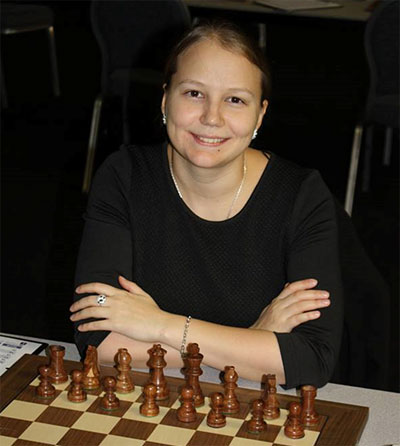
Valentina Gunina’s victory over Ekaterina Pavlidou
played an important role in Russia’s 3:1 win against Greece

Second board for Ukraine, Natalia Zhukova, will try to
make sure that her team repeats the success of 2013
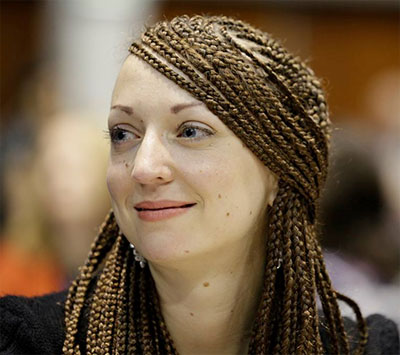
Recently married Elisabeth Pähtz sports a new hairstyle
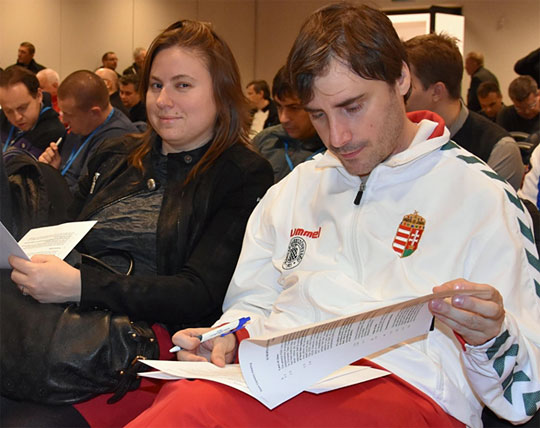
What?? Judit’s here! Well, unfortunately she isn’t playing. She is the coach of Hungarian men’s team.
The coach of the women’s team GM Robert Ruck can be seen next to her in the above picture.
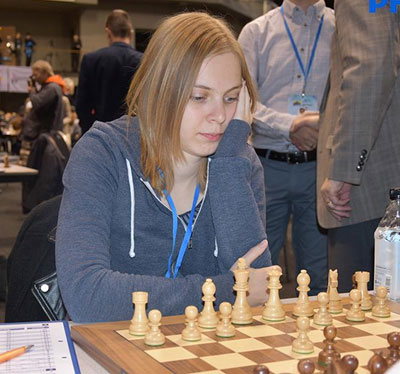
Board one for Netherlands WGM Anne Haast
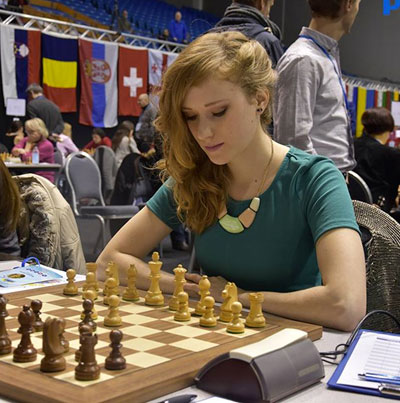
The three-time Hungarian champion Anna Rudolf plays on board two for her team
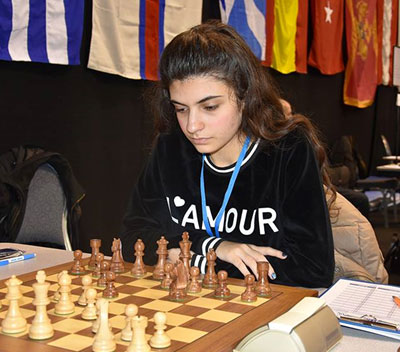
Anna-Maja Kazarian must have become a stronger player
after her 5.5-0.5 loss against Sopiko Guramishvili recently
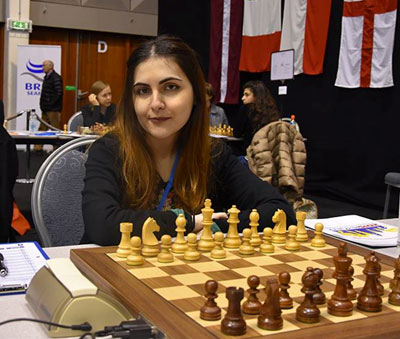
Board number two for Spain IM Ana Matnadze
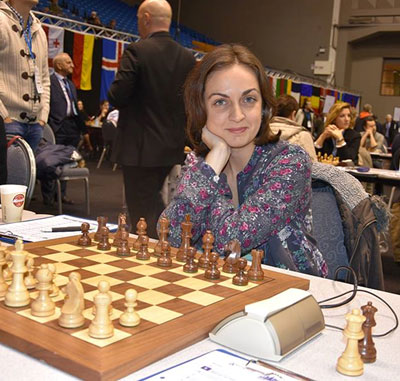
One of the best photographers in the chess world and also
a strong chess player, IM Alina l’Ami, plays under the Romanian flag
Round one results
| No. |
Sd |
Team |
MP
|
Pts.
|
: |
Pts.
|
MP
|
Team |
Sd |
| 1 |
16 |
Czech Republic |
0
|
½
|
: |
3½
|
0
|
Georgia |
1 |
| 2 |
2 |
Russia |
0
|
3
|
: |
1
|
0
|
Greece |
17 |
| 3 |
18 |
England |
0
|
1½
|
: |
2½
|
0
|
Ukraine |
3 |
| 4 |
4 |
Poland |
0
|
3½
|
: |
½
|
0
|
Austria |
19 |
| 5 |
20 |
Slovenia |
0
|
1
|
: |
3
|
0
|
France |
5 |
| 6 |
6 |
Armenia |
0
|
2½
|
: |
1½
|
0
|
Latvia |
21 |
| 7 |
22 |
Montenegro |
0
|
2
|
: |
2
|
0
|
Germany |
7 |
| 8 |
8 |
Romania |
0
|
2½
|
: |
1½
|
0
|
Norway |
23 |
| 9 |
24 |
Switzerland |
0
|
2
|
: |
2
|
0
|
Hungary |
9 |
| 10 |
10 |
Netherlands |
0
|
2
|
: |
2
|
0
|
Lithuania |
25 |
| 11 |
26 |
Denmark |
0
|
1
|
: |
3
|
0
|
Spain |
11 |
| 12 |
12 |
Serbia |
0
|
4
|
: |
0
|
0
|
Sweden |
27 |
| 13 |
28 |
Belgium |
0
|
1
|
: |
3
|
0
|
Azerbaijan |
13 |
| 14 |
14 |
Turkey |
0
|
3
|
: |
1
|
0
|
Iceland |
29 |
| 15 |
30 |
Finland |
0
|
0
|
: |
4
|
0
|
Italy |
15 |
Full individual results
Pictures taken from the official facebook page of ETCC 2015
Links
The games are being broadcast live on the official web site and on the chess server Playchess.com. If you are not a member you can download a free Playchess client there and get immediate access. You can also use ChessBase or any of our Fritz compatible chess programs. |
|
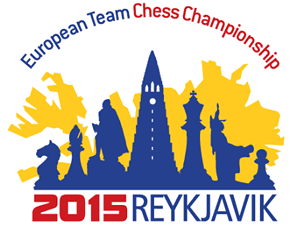



























 Viktor Bologan: The Berlin Wall
Viktor Bologan: The Berlin Wall











